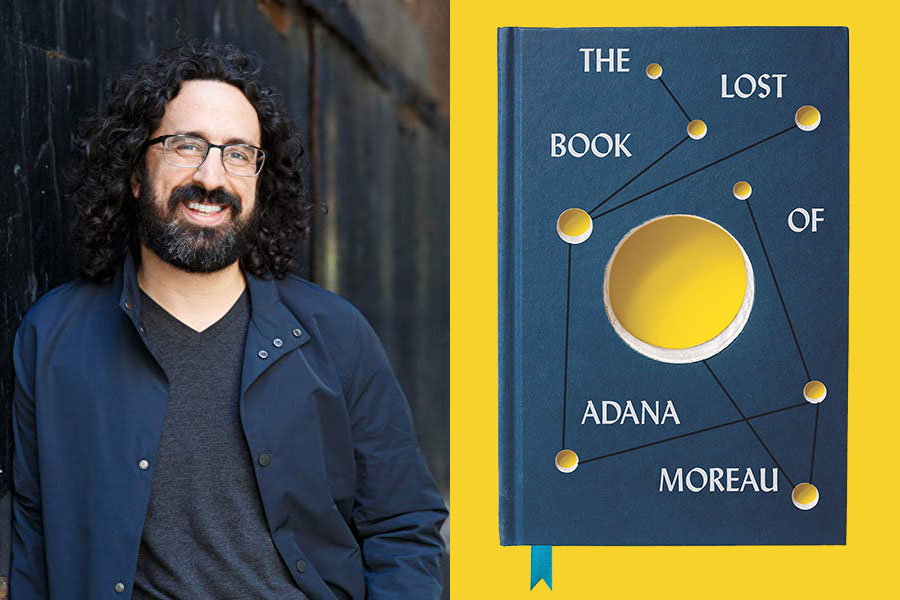In a review of Michael Zapata’s debut novel The Lost Book of Adana Moreau, The New York Times counts 28 made-up books mentioned in the text, from a Bolivian novel about a spaceship that must reckon with a perplexing crime to a cosmology book positing the existence of the multiverse.
“When you weave all these imaginary novels together, it creates a literary landscape through which you can understand your characters,” Zapata says.
The novel at its center is Model Earth, a Lovecraftian sci-fi fantasy by the titular Adana Moreau, a Dominican woman whose rebel parents are killed by U.S. Marines in 1916. She marries a pirate, known as “the last pirate of the New World,” who sets sail to New Orleans. The unfinished manuscript binds the fates of her son Maxwell, a theoretical physicist who dreams of parallel universes, and Saul Drower, a hotel clerk in Chicago tasked with delivering the mysterious tome to Maxwell in the aftermath of Hurricane Katrina.
Rich in imagination, The Lost Book of Adana Moreau is a gorgeous, heartbreaking examination of exile, diaspora, and family that spans multiple narratives across space and time. I spoke to Zapata, a founding editor of MAKE Literary Magazine and academic advisor at the School of the Art Institute, about his local inspirations and dual fascination with New Orleans and Chicago.
Did The Lost Book originate with a particular scene or character?
The very first sentence I wrote, "His father was a pirate," was the same eight years ago as it is today. I tend to write sentence by sentence. If there's any scene that emerged, I knew I wanted to write about New Orleans — as a port city, as a parallel universe. I've always been attracted to it. I hadn't lived in New Orleans at that point [when I started writing], but I had been going two or three times a year for my whole life since I've been 18.
Why?
It magnetizes. New Orleans pulls you in. I'm Latinx — my father's from Ecuador and I've been going my whole life — and there was something that felt very familiar about New Orleans. Not just in the architecture, or the pace of life, but it felt very much like a Latin American city trapped in America.
The novel has a wide scope, spanning the 2001 Argentine Great Depression, 1930s Chicago, and post-Katrina New Orleans. How did you balance those storylines?
So much of what they have in common are these catastrophic responses to capitalism — situations where change is imminent and likely necessary. I always think of it in terms of how the past and the future collide in the present, and the possibilities that exist in the future for people who are in the midst of a revolution. While they're very different historical records, very different nations, I feel like the people in these historical moments of disaster capitalism or revolution are sharing similar thoughts, feelings, and philosophies about it.
What kind of historical research did you do?
I had started, like anyone is supposed to, reading historical books about the Great Depression or the Russian Revolution. They were helpful, but I didn't get to the historical record that I wanted until I started looking into the oral tradition. Are you familiar with Studs Terkel?
That’s exactly who I thought of when you introduced the character of Benjamin Drower.
Perfect! That’s awesome. I did model a lot of the work that Benjamin Drower does on Studs Terkel. Even Vox Humana [the oral history project Benjamin conducts] was taken from something Studs Terkel always said about his own work, "the human voice." What he was able to do to get people to truly paint a portrait of themselves — to not only offer up what they went through on paper and with their voice, but to offer a true narrative of who they were. It's beautiful the way he does that.
Instead of getting weighed down with the world-building — sometimes historical fiction can feel weighty with all those details — the most important thing was finding people's voice and then giving life to that.
One of the main characters, Saul Drower, lives in Chicago, and there are a lot of familiar references: walking down Montrose Beach with his grandfather, getting breakfast at the Golden Nugget Pancake House at Diversey and Western, daydreaming on the #72 bus. What made you decide to ground this part of the narrative in Chicago?
Like New Orleans, Chicago is a port city. It's a place where exiles and immigrants have ended up for the past 150 to 200 years. I grew up in Old Irving Park and Roselle, a suburb of Chicago. My father is a jeweler, recently retired, but I would work with him on Jewelers Row. My mother's family's Lithuanian Jewish, and they've been here for 100 years [since] they escaped pogroms in the early 20th century. Chicago has been integral to my life.
It also forced me to reconcile how much Chicago has changed since the 1930s [and] what 70 years does to a person, what it does to a neighborhood, and what it does to a city. It felt like a puzzle that I wanted to play around with.
Not to go too much on a tangent, but Italo Calvino has this amazing collection of short stories and prose poems called Invisible Cities. I've always been fascinated with this idea of cities existing inside of cities. I think the United States is hyper-aggressive in erasing histories, but you do have places like New Orleans and Chicago, which by necessity inhabit their own histories.
What was fun about researching them, particularly Chicago, is this obsessive idea that you can't ever get to [the innermost city]. I'm 40 and I've spent the vast majority of my life here, and I don't know if I'll ever get to the center. But that's a joy. It's a labyrinth that is an absolute joy to research and write about.



